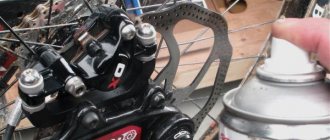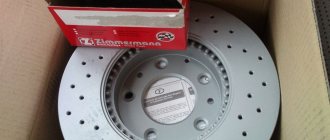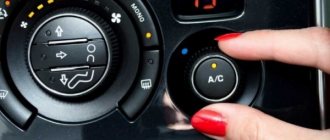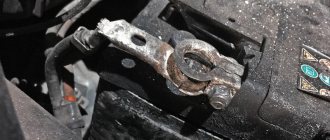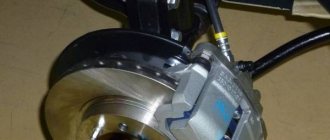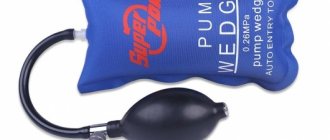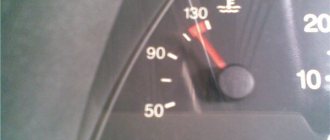Imagine the situation - you are driving a car, press the brake pedal; the pedal falls to the floor, and the car continues to move at the same speed. The situation when the brakes are lost is not only unpleasant, but also deadly. Dangerous for all types of transport: from small cars to heavily loaded trucks. Any driver can find himself in this situation. The first reaction for beginners is panic. Experienced drivers, if they have not found themselves in such situations, then at least in theory know what to do and in what sequence. We will tell you how to reduce the speed of a car until it comes to a complete stop in a situation where the brakes have stopped working.
Causes of brake system failure
The most important reason is a break in the line through which the working brake fluid circulates. Such breaks occur due to strong impacts from stones, due to collisions with curbs, due to severe wear. As you can see, there are many possible causes for this problem, but the effect is the same - the brakes have failed. Due to a broken pipeline, the working fluid will leak out of the system, and the cylinder will not be able to compress the pads.
It is also common for the brake master cylinder to fail. Whatever the reason, the main thing in such a situation is not to panic or lose composure. There are effective ways to stop a car in an emergency.
Let's look at what to do if the brakes fail at speed. This is necessary and important information. There are several options for reducing speed without the need to use the parking brake. Many people in this situation grab the handbrake, but in a panic, few people think that this can lead to a skid or even a rollover.
Before starting emergency braking, it is recommended to press the pedal firmly and sharply several times. If the car does not have standard ABS, then these actions will create the necessary pressure in the system. This will help when the brakes fail due to something other than a pipe break. Maybe air just got into the system. It is also not uncommon for an object to get under the brake pedal - it can block pressing.
Experts recommend not turning off the engine in such situations. If you need to stop immediately, and the road section is small, then you can put the car into a skid until it goes into a ditch or hits some obstacle. This is justified when there are pedestrians or various dangerous objects in front of the car.
How to stop a car
Before moving on to braking methods, you should remember that panic in this situation can lead to an accident, since the driver will either simply scream in fear or begin to unjustifiably pull the parking brake, which in turn can skid the car and carry it into a ditch.
Before using emergency braking, try pressing the brake pedal sharply several times. If your car is not equipped with an ABS system, then pressing hard several times will help increase the fluid pressure and subsequently restore the functionality of the brakes. It also often happens that there is an object in the cabin under the pedal that prevents the brake pedal from being pressed.
Also, under no circumstances should you turn off the car’s engine, since many models are equipped with a hydraulic booster or electric booster, which do not work when the engine is not running, and they can help you control control if a skid occurs. Also remember that a sharp decrease in vehicle speed can cause a skid, and subsequently a possible rollover; also be careful when using the methods listed below.
Let's start the engine
If your car's brakes fail, you can try to stop it using the transmission system. This is one of the most popular and safest methods of reducing speed. This procedure is performed by engaging lower gears. Engine braking is not only the safest possible under any road conditions, but also, if done correctly, will not cause a skid. When performing this operation, you need to remember several basic nuances.
Don't turn it on very sharply. Such actions can cause the drive wheels to slip and thereby increase the risk of skidding. The lower the gear, the sharper the car will dive.
Why do the brakes fail?
Brakes can stop working for a number of reasons. The two most common are related to the brake fluid and the operation of the brake mechanism that presses the pads to the brake rotor. Both causes can be easily diagnosed with regular maintenance. To ensure your brake calipers last a long time and don't cause problems, try not to overload them and overheat the brake system by braking too often and for too long. Always start braking early, from a greater distance, this will be safer from a driving point of view, and will also not put additional stress on the calipers and brake lines.
How to brake with a manual transmission engine
If the brakes fail, but you have a manual transmission, you can stop quite effectively. But you need to use the engine correctly. To reduce the risk of skidding, only shift down one gear. You should not immediately engage third gear from fifth gear. When driving in fifth, turn on fourth and wait for the moment when the car twitches and then turn on third. When the car begins to twitch at first, only then can you turn off the engine. If the truck's brakes have failed, this approach will not help. A loaded car spins the engine very well, and the speed will not decrease.
There is also a “re-gas” - this should be remembered by owners of Soviet cars. In normal situations, when shifting into gear, the driver waits until the speed decreases to engage the lower gear. But in emergency situations there is no time to wait. Therefore, after switching off the gear, you must press the gas to equalize the speed and then change gear. This way we will reduce the “peck”, which is very harmful to the elements of the engine and transmission.
A few more tips
In such an unforeseen situation, there are still options for how to brake if the brakes fail. You can take the advice of experienced people and try to brake using the gas. To do this, you need to press the gas and engage reverse gear. Since the drive wheels will rotate in reverse, the vehicle must stop immediately and may even go in the opposite direction. This braking method is only effective if you have a powerful enough engine.
If the engine is too weak to brake, try sequential gear shifting. To begin, press the clutch, shift the gearbox to a lower gear, then immediately step on the gas. By increasing the rotation speed, you will be able to shift without jerking, which is dangerous at speed. For the next step, simply release the clutch. Repeat this three times.
If your car has a manual transmission, then turn off the ignition completely and do not depress the clutch. Of course, braking will be harsh and this will affect the engine in the future, but it will be effective.
With an automatic transmission, you need to turn off the engine so that the ignition does not reach the stop, otherwise your steering system will automatically turn off. If you don't mind your transmission, just put it in park. There are “automatic machines” that switch to manual switching. If you have this function, use it and brake the engine.
Engine and automatic transmission braking
On cars equipped with automatic transmissions, you can perform the same steps. To do this, the automatic transmission is switched to manual control mode. If it is not available in this automatic transmission model, then the lever is moved to the third or second gear position. This is to force the car, albeit slowly, to reduce its speed. You can also install an automatic transmission in parking. But if the brakes fail, this approach will be effective only when the distance is short and you need to brake at all costs.
In this case, the automatic transmission will be blocked. There is a serious possibility that the car will skid, and the automatic transmission mechanism will be broken and it will have to be thrown away. But it’s much better and cheaper than someone’s life.
How to brake in reverse gear
This is another way to perform emergency deceleration to a complete stop. This is braking by engaging reverse gear. In real life, this method cannot be used - the method is fraught with the complete replacement of the clutch kit and other transmission parts. However, this method is not always suitable if the brakes have failed. Efficiency largely depends on the condition of the gearbox and its type. Some modern gearboxes are equipped with special locking mechanisms that prevent reverse gear from being engaged while the car is moving forward.
On simpler gearboxes, reverse gear can be engaged. To do this, release the clutch and press the gas. The effectiveness of braking depends on the speed of the vehicle, as well as engine power. Often after this you have to change not only the clutch, but also the entire power part - the gearbox and engine. This braking can also cause accidents. The car may drift onto the side of the road or into the center of the roadway, into the oncoming lane. Plus, cars behind you won't be able to stop as quickly as you can.
This method involves creating an emergency situation on the road; after use, the engine and gearbox become unusable. What to do if the brakes fail at speed? Let's consider all the nuances in more detail.
We use the handbrake
Also, along with the methods already described, there is one more. It involves the use of a handbrake. If the brake failure does not lead to the handbrake failure, then you can use it. But you need to remember that there is a certain risk of getting into a skid.
The best result, allowing you to stop as quickly as possible, is to combine engine braking with the use of the so-called handbrake. When the car begins to slow down due to the low gear being engaged, apply the parking brake and drive until it comes to a complete stop. It is important to press the mechanism button before the entire procedure and not release it. If the wheels are locked, this will prevent the car from skidding.
Algorithm of actions
1. Don't panic! All that will help you save yourself and others now is the ability to think clearly and act quickly. Panic will make the situation really critical.
2. Turn on the emergency lights ! Signal to cars and people ahead. Open the window, firstly, this will worsen the aerodynamics of the car, and secondly, you will be able to warn other road users with your voice that your brakes have failed.
3. Take your foot off the gas pedal, turn off the cruise control if you are driving a car with an automatic transmission.
4. Try bleeding the brakes . To do this, press the pedal vigorously several times in intermittent movements to release pressure in the brake system. Don’t stop trying, even when you try to slow down using other methods - there is a chance that the pressure will be restored and the “brakes” will return.
5. Brake with the engine. To do this, switch in a manual transmission from 4th gear to 3rd or immediately to 2nd. Downshift gears must be quickly but smoothly. You cannot drop the clutch, this can lead to a skid or the car will stall.
On an automatic transmission, switch to manual mode and lower the gear too. If there is no manual mode, go from mode D to position 1.
6. Engage the handbrake , but do not sharply! Pull the lever slowly and continuously. The handbrake will brake the rear wheels. If you hear the brakes squealing, this does not mean that they are locked. Pull the lever until it clicks three times, then another 1-2 clicks until it stops completely.
If your car has an electromechanical handbrake, you can try to “tighten” it too! To do this, you need to hold the button for a long time and press the brake pedal. For the electronic system, this is a signal for an emergency stop.
7. Combine methods: when lowering a gear, brake smoothly using the handbrake.
8. If you are alone on the road and the speed is low, turn the steering wheel slightly from side to side. Turning will increase wheel friction and the car will slow down. This should not be done at high speed and on a busy highway!
9. Try to drive onto the curb to stop the car. Just keep a firm grip on the steering wheel and angle the car toward the curb to get over it. Otherwise, you may be thrown back onto the road.
10. If you don't have time to slow down the car and you're flying into people, use EVERYTHING SURROUNDING YOU to STOP the car. A curb, a snowdrift, a slope, a safety fence, any object or thing that you can rub your side against to stop the car. Outside the city - drive onto gravel, dirt or grass, only as smoothly as possible to prevent the car from tipping over. Direct the car towards small (!) trees and bushes.
11. If the situation is critical and hopeless, hit the back of another car. It is advisable that he drives at the same speed - the impact on a stationary car may be too serious.
12. Before step 9, try to at least lower the gear and slow down as much as possible.
13. Do not turn off the engine if the brakes fail! You will lose control of the car this way. But if in a panic you pull the key out of the ignition, insert it back, turning it to the second position. So at least the steering wheel won't lock.
14. When your brakes fail and you stop, do not try to continue driving. Even if the pedal works again, the cause of the problem must be found out and fixed. Call a tow truck.
How to brake on obstacles
What to do if the brakes fail and the car does not want to stop, but you are moving in traffic? If there is not enough room for braking, then you should try to brake against some obstacle. This is the most extreme case.
Most professional drivers recommend stopping not with a direct frontal impact, but tangentially to this obstacle. This will make it possible to reduce the speed, and the damage will be minimal. At high speed, this method can save lives.
You should not slow down on an obstacle next to which there are people. When a collision is imminent, the car is directed to hit the front car with the bumper. This allows you to reduce speed and also reduce damage for both cars.
Braking against an obstacle
The most extreme option is braking against an obstacle; it should be used only if the previous methods are ineffective or do not work at all. It is advisable to use something soft as a barrier; also make sure that you and all passengers are fastened.
It is recommended to slow down the car not with a direct impact, but with a tangential one, that is, rubbing the side of the car against something, for example, the edge of an expensive metal profile road, a bush, if it is a city, then a high curb will do. During this, you must constantly adhere to the trajectory. During such braking, you will cause relatively little damage to your car and at the same time save your life and the lives of your passengers.
You should not try to stop on an obstacle near which there are people. Also, if you decide to stop against a car, then it is advisable to try to get bumper to bumper as much as possible, since this is the most effective, causes less damage to the car and does not throw the car from the front into the oncoming lane, and you will not be to blame for someone’s death.
Aerodynamic braking
If you have the opportunity to try to stop the car at a long distance, then you can use this method together with the previous methods. The task is to open the car doors, while being sure to wear a seat belt. As a result, blowing air will slow down the car.
How to brake on mountain roads
In the mountains, it is worth remembering that before sharp turns there are special emergency stop pockets. It is worth saying that it is often in such places that beginners get into accidents. They think that the brakes will not fail on a descent, but when they are actively used, it is on the descent that the entire system fails. Beginners usually use the pedal instead of the transmission to brake. As a result, the pads jam on one of the axles. Therefore, in such cases, be sure to use a lower gear and, if necessary, drive into the “catching” pocket. This is the only way to stop safely without serious damage.
A car's braking system is by far the most important part in terms of driving safety, and malfunctions in it can have fatal consequences. Why can the brakes fail on a car?
The most common cause of problems with the most pressed pedal in a car is depressurization or rupture of the system pipe. A depressurized line cannot maintain the level of the working fluid, as well as the pressure at the proper level. This does not always result in complete loss of brakes, but the risk of getting into an accident increases significantly.
How to handle it?
Brake fluid must be stored in an airtight container to avoid contact with air. Because because of this, the liquid may begin to gradually oxidize, accumulate a large amount of unnecessary moisture, or simply evaporate.
You also need to remember that brake fluid is a flammable and flammable substance. Therefore, smoking or simply “playing around with matches” next to her is fraught with not the most pleasant consequences. In addition, “brake fluid” is poisonous, and if it enters the body it can even lead to death. If liquid does get inside, you need to rinse your stomach as soon as possible. If it gets into your eyes, rinse them with clean cold water. And, of course, you should immediately see a doctor.
What's in the brakes...
Why do the brakes fail?
On modern cars, the braking system, as a rule, consists of two closed circuits. Each circuit works on its own pair of wheels, and these circuits can be connected either parallel or diagonally. This is done in order to increase the survivability of the system; if one circuit fails, the car does not lose its brakes; this function continues to be performed by the second circuit. Of course, when working on one circuit, the braking efficiency is greatly reduced, the braking distance increases two or more times, however, the machine can reduce the speed to a minimum or stop if necessary.
Brake lines
The weak link of the brake system is considered to be the channels, which most often remain open and unprotected from mechanical damage. This could be impacts from stones, as well as the bottom of the car hitting an obstacle. Fluid leaks and the slave cylinder cannot compress the pads tightly enough. Also, the cause of brake failure can be simple cylinder wear, malfunctions in the vacuum pump, old worn gaskets and seals, and other components of the vehicle’s brake system that were not replaced on time.
Car brake system
Often the cause of braking problems is an old caliper with acidified guides and a jammed piston. Hence, the main responsibility for the serviceability of the car’s brake system, its quality, and condition lies with its owner. If we didn’t replace the brake fluid in a timely manner, we got a problem, since we know that the fluid is hygroscopic and absorbs moisture quite quickly. The quality is greatly reduced.
In modern cars, which today are literally crammed with all kinds of electronics and sensors, problems often arise due to a failure in one of the electronic units that interact with the braking system, which can cause a failure in the distribution of braking forces.
Compliance with operating rules and timely maintenance significantly reduce the likelihood of problems with the brake system.
Driving safety in a car depends on the performance of the braking system. Therefore, even the traffic rules state that the operation of vehicles is strictly prohibited if the brakes are faulty.
But even responsible drivers who regularly perform maintenance can have problems with their brakes. In this case, the primary task is to stop the car, and this must be done as quickly as possible and without consequences. But doing this is not as easy as it seems.
Testing device
Progress, as we know, does not stand still. Therefore, now there are a variety of devices with which you can check the condition of the brake fluid.
In principle, these devices are not complicated. You don’t even have to scroll through the instructions looking for Russian words. You just need to connect the clamps to the battery, lower the dipstick into the fluid reservoir and see what readings appear on the scale.
Since these devices are professional and intended for car services, they can be used to determine the “well-being” of the brake fluid at a fairly high level.
Just a few minutes of time spent can say a lot about the state of the entire system. And most importantly, answer the question: is it time to change the brake fluid, or can you still drive with the old one?
Tags: cars • cars • cars • brakes • transport
Causes of malfunction
Main causes of brake failure:
- Damage to the lines through which brake fluid moves and fluid leakage
- Master cylinder pistons jamming.
- Damage to the master cylinder seals.
- Critical wear of pads or brake discs.
- A foreign object gets under the pedal.
- Low brake fluid level, fluid leak.
- Brakes can also fail due to old brake fluid, it absorbs water from the air, and the water boils → air in the brake system → brake failure.
Some of the reasons lead to a significant decrease in the effectiveness of the braking system, but it continues to function. And this is already a positive moment. But there are also malfunctions in which the system completely fails.
To stop a car with failed brakes, braking is applied by the power plant with the transmission and obstacles. But the second option is emergency and is used only as a last resort - to avoid serious consequences.
Requirements for the “brake guard”
The main requirements for brake fluid are viscosity and boiling point. But there are other, no less important parameters. For example, the absence of any impact on the rubber cuffs located between the cylinders and pistons of the hydraulic drive. The fact is that liquid in contact with rubber can increase the latter in volume. But this impact should not be too strong.
Of course, protecting the metal from corrosion also plays an important role. The brake system is designed in such a way that good conditions are created for the appearance of “red stuff” - after all, different components are made of different metals. To avoid corrosion, the brake fluid is “pumped” by adding various inhibitors, which are responsible for the safety of metal, aluminum, brass, cast iron and copper parts.
We must not forget about lubrication of friction pairs. After all, the lubricating properties of brake fluid affect the wear of the surfaces of cylinders, seals, and pistons.
And, of course, stability of operation under strong temperature fluctuations is important. Ideally, brake fluid should not change its characteristics in the range from -40 to +100°C. At the same time, it does not succumb to oxidation, delamination and successfully resists the appearance of all kinds of deposits.
Actions in case of brake failure
So, when trying to brake, the pedal fails and there is no deceleration. This happens when the lines are damaged, there is a leak, or there is a lack of brake fluid. Such malfunctions fall into the category of partial loss of effectiveness of the braking system.
The design of the system provides for the presence of two independent circuits, each of which is responsible for two brake mechanisms. If one circuit is damaged, the machine retains the ability to stop. In this case, due to a non-working circuit, the pedal force will drop significantly, and the second circuit may not work immediately. This is due to the fact that due to a leak, the volume of fluid in the tank is reduced to a critical level and in order to activate the remaining working brake mechanisms, fluid must be pumped into the line. This is done by repeatedly pressing the pedal (2-3 times). As soon as you feel that the car has begun to slow down, press the pedal and hold it in this position until it comes to a complete stop.
If the pedal falls completely without effort or it is stuck in the released position, a breakdown of the system has led to its complete failure and manipulating the pedal will not help. In this case, we take other measures - deceleration due to the engine and gearbox.
Stopping with engine and transmission
The driver's actions when the brakes fail depend on the design of the transmission and parking brake. It’s easier to stop a car with a manual transmission, but with a CVT and automatic transmission it’s more difficult, but possible.
An important condition for stopping a car is reducing the speed. And this can be done with the engine and gearbox. With certain manipulations, it is possible to reduce the speed, and without negative consequences for the transmission and engine.
It is easier to brake with the engine if the car has a manual transmission.
Deceleration technology: take your foot off the gas pedal and slow down by shifting to low gears and depressing the clutch as quickly as possible. But keep in mind that the transition must be consistent and quick. It is impossible to move in 5th gear and immediately engage 1st. This will lead to damage to the engine and transmission and loss of controllability. The consequences of improper braking are negative - flying off the road, drifting into the oncoming lane, turning the car over.
After switching to the lowest gear, we stop the car by stopping the engine or using the handbrake. But you shouldn’t turn off the engine right away while the car is still moving at a significant speed. Such measures will lead to a rupture of the gearbox and severe damage to the engine, while the car will become uncontrollable.
With an automatic transmission and CVT it is more difficult to stop the car. In such boxes, the protection system will not allow you to forcibly change the gear ratio. And even if such boxes have a manual mode, then when switching from a high gear to a low one, the system will monitor the operation of the transmission in the set mode and, if there is a discrepancy, it will independently switch to a higher speed. The presence of a manual mode will ensure a faster stop of the machine. Using it, acting as with a manual transmission (sequential transition from high speed to low), we achieve rapid deceleration.
But if there is no manual mode, then the driver can release the gas pedal and continue to drive the car, waiting until the transmission itself switches to the lowest gear, and then use the handbrake or turn off the engine. The only thing that can be done additionally is to set the selector to the “L” or “1” position (if such a mode exists). In this mode, the transmission switches to low gears faster.
Using the handbrake
The handbrake is a cable-operated brake that helps stop the car, but you cannot tighten it immediately and all the way, so as not to lose control. When slowing down the car with the engine and gearbox, also turn on the handbrake. At the same time, hold down the ratchet key and pull the lever up gradually. With such actions, the mechanical drive will ensure that the rear brakes are activated, and they will begin to slow down the car. It is important not to overheat the pads in order to maintain the functionality of the handbrake.
The optimal actions are as follows: let off the gas, switch to a lower gear and briefly apply the handbrake. Then we lower the lever and quickly repeat the procedure. And only when we reach the lowest gear do we squeeze the handbrake.
But if the car is equipped with an electric handbrake, then it cannot be used to slow down. In a mechanically driven mechanism, the driver adjusts the pressing force of the pads, eliminating complete blocking of the wheels. The electric drive will immediately block the mechanisms, which will lead to loss of control. Therefore, we use a handbrake of this design only after the speed has been reduced, when all that remains is to completely stop the car.
The same applies to the parking brake, which blocks the gearbox. In this case, its activation will lead to a rupture of the gearbox, damage to the engine and loss of controllability.
Video: What to do if the brakes fail, the car has no brakes
Using Obstacles
All described methods of stopping with failed brakes are applicable only if driving conditions allow. It takes a long distance to stop the engine and transmission. But it also happens that the brakes fail, and the car needs to be stopped urgently.
In this case, all that remains is to take advantage of the obstacle, but you still need to choose it correctly. The best way to stop a car through an obstacle is to drive into a snowdrift. In this case, the consequences are minimal.
You can also use bump stops, but keep in mind that the first time your side touches an obstacle, the car can be thrown to the side, so it is important to hold it.
You should only drive into trees and metal structures located near the road if there are no other obstacles. You should not urgently stop your car by driving into another car.
When the brakes apply, it is important to maintain composure and act quickly.
Driving a car requires composure, attentiveness, and, of course, quickly making the right decisions in emergency situations. A car, as a vehicle of increased danger, carries certain threats to others and the driver himself.
The worst thing that can happen to a car is when the brakes fail. Only then does the driver understand his helplessness in this situation. The car is rushing at all speeds and cannot be stopped. The most terrible fatal accidents occur, including due to faulty brakes.
Brake system malfunction
Brake failure while driving is a difficult situation that can lead to irreversible consequences. If you are faced with such a problem, then you need to act clearly and quickly; under no circumstances should you indulge in panic, as it will prevent you from resolving the situation favorably.
What are the ways to stop a car and what should you do if the brakes fail while driving?
There can be many reasons for failure of the brake system, the most common is a drop in the level of brake fluid , the necessary pressure is not created in the master brake cylinder. In this case, you can try to bleed the system - press the brake pedal all the way and release it 5-15 times. It should work.
If you see that the car does not stop, the pedal has failed or is jammed and does not give in, then you need to act quickly. Try to attract attention to yourself - turn on your emergency lights, honk your horn loudly so that surrounding drivers and pedestrians see that you are in trouble and stay away.
Stop the car by shifting to lower gears , this is easy to do if you have a manual transmission, shifting through several gears will quickly reduce the speed. True, this method is unlikely to help you if you need to brake sharply.
On cars with an automatic or robotic transmission, abrupt switching from upshifts to downshifts can result in transmission failure. The electronics will take care of the box and switching will not happen as quickly as you would like. On more modern models, it is possible to switch to manual control; move the selector from position “D” to position “1” or “L” .
the parking brake to stop . Hold the lever in the unlocked position while pressing the release button. Gradually, not very sharply, pull the lever up so that the rear wheels brake smoothly. If you pull the brake very sharply, then with a high degree of probability the car will lose control.
One of the extreme ways to stop a car is to turn off the ignition at full speed , the engine will stall and will run for some time by inertia, when the speed drops, you need to switch to first gear. This method will almost completely lead to a breakdown of the gearbox, but it is still much better than being disabled or hitting a pedestrian.
If you have passengers in the cabin, they should also take measures to stop the car as quickly as possible; you can lower the windows or open the doors slightly, the aerodynamic indicator will decrease and the car will stop faster. If the situation is very difficult, then you can try to move into a ditch, but not too sharply or skidding, otherwise the car may tip over.
Use various objects to stop, for example, wheel friction on curbs, road fences; if there are bushes or snowdrifts on the side of the road, then this is an ideal option, since you can stop with minimal damage. In the most extreme cases, you need to use nearby vehicles, preferably trucks with a booth or semi-trailer. If you see a KamAZ-type dump truck, then it’s better not to take risks, because if you drive under the rear axle, you can be left without a roof.
How to avoid problems with the brake system?
First, you need to regularly check your brake hoses, especially where they bend. The presence of even the slightest crack indicates that it is time to change the hoses. You need to clearly know the design of your car’s brake system and the number of hoses.
If even one hose is cracked, the entire set must be replaced at once.
Secondly, check the brake fluid level in the reservoir. Buy only liquid recommended by the manufacturer. Also inspect the brake pads, do not allow them to wear out completely. If you notice that the brake pedal is pressed softer or harder, then immediately look for the reason for this.
( 2 ratings, average: 5.00 out of 5)
